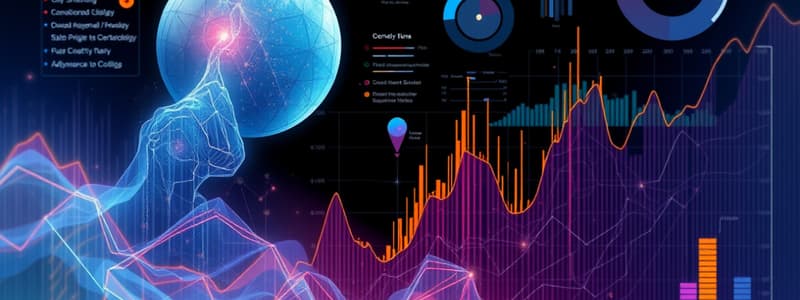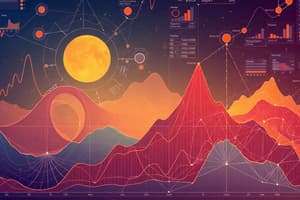Podcast
Questions and Answers
What is the primary purpose of data visualization?
What is the primary purpose of data visualization?
- To enhance comprehension and aid decision-making. (correct)
- To create complex data models.
- To collect raw data efficiently.
- To fill databases with information.
Which type of visualization is most suitable for showing trends over time?
Which type of visualization is most suitable for showing trends over time?
- Pie Chart
- Scatter Plot
- Bar Chart
- Line Chart (correct)
What is a common mistake made in data visualization?
What is a common mistake made in data visualization?
- Overcomplicating visuals with excessive information. (correct)
- Using consistent colors and scales.
- Providing context and labels.
- Choosing the right type of visualization for the data.
Which tool is known for its user-friendly interface for creating interactive dashboards?
Which tool is known for its user-friendly interface for creating interactive dashboards?
In data visualization, what is a heat map used for?
In data visualization, what is a heat map used for?
What should be avoided to ensure clarity in data visualization?
What should be avoided to ensure clarity in data visualization?
Which option is NOT a type of graph used in data visualization?
Which option is NOT a type of graph used in data visualization?
Why is it important to consider accessibility in data visualization?
Why is it important to consider accessibility in data visualization?
Flashcards are hidden until you start studying
Study Notes
Data Visualization in Data Analytics
-
Definition: Data visualization is the graphical representation of information and data. It uses visual elements like charts, graphs, and maps to make data more accessible and understandable.
-
Importance:
- Enhances comprehension of complex data sets.
- Facilitates quicker insights and decision-making.
- Aids in identifying trends, patterns, and outliers.
-
Types of Visualizations:
- Charts:
- Bar Charts: Compare quantities across categories.
- Line Charts: Show trends over time.
- Pie Charts: Display proportions of a whole.
- Graphs:
- Scatter Plots: Illustrate relationships between two variables.
- Histograms: Show frequency distributions.
- Maps:
- Heat Maps: Visualize data density or distribution across geographic areas.
- Choropleth Maps: Use color to represent data values across regions.
- Dashboards: Integrate multiple visualizations for a comprehensive overview.
- Charts:
-
Tools for Data Visualization:
- Tableau: User-friendly interface for creating interactive dashboards.
- Power BI: Microsoft tool for business analytics and reporting.
- D3.js: JavaScript library for producing dynamic, interactive data visualizations.
- Google Data Studio: Free tool for creating reports and dashboards.
-
Best Practices:
- Determine the purpose of the visualization (e.g., comparison, trend analysis).
- Choose the right type of visualization for the data.
- Maintain clarity and simplicity; avoid clutter.
- Use consistent colors and scales to enhance understanding.
- Provide context and labels to ensure the audience can interpret the data accurately.
-
Common Mistakes:
- Overcomplicating visuals with excessive information.
- Misleading representations (e.g., distorted scales).
- Lack of accessibility considerations (e.g., color blindness).
-
Applications:
- Business Intelligence: Analyzing sales data and customer behavior.
- Healthcare: Visualizing patient data and trends in public health.
- Scientific Research: Presenting complex data from experiments and studies.
-
Future Trends:
- Integration of AI and machine learning for predictive analytics.
- Increased use of augmented and virtual reality for immersive data experiences.
- Growing emphasis on interactive and real-time data visualization tools.
Data Visualization in Data Analytics
- Data visualization transforms information into visual formats such as charts, graphs, and maps to enhance accessibility and understanding.
- Crucial for interpreting complex data sets, it promotes faster insights, supports decision-making, and helps identify trends, patterns, and outliers.
Types of Visualizations
- Charts:
- Bar Charts: Ideal for comparing quantities across different categories.
- Line Charts: Effective for showcasing trends over time.
- Pie Charts: Useful for illustrating proportions of a total.
- Graphs:
- Scatter Plots: Display relationships between two variables to reveal correlations.
- Histograms: Visualize frequency distributions to understand data spread.
- Maps:
- Heat Maps: Indicate density or distribution of data across geographical areas.
- Choropleth Maps: Employ color coding to represent data values across regions.
- Dashboards: Combine multiple visualizations to provide comprehensive data overviews.
Tools for Data Visualization
- Tableau: Known for its user-friendly interface, facilitating the creation of interactive dashboards.
- Power BI: A Microsoft tool designed for business analytics and reporting functions.
- D3.js: A JavaScript library that enables developers to create dynamic, interactive visualizations.
- Google Data Studio: A free tool offering robust options for report and dashboard creation.
Best Practices
- Clearly define the purpose of the visualization, whether for comparison or trend analysis.
- Select the most appropriate type of visualization based on the specific data.
- Focus on clarity and simplicity to prevent information overload.
- Use consistent colors and scales to maintain coherence and enhance understanding.
- Include context and labels for accurate audience interpretation.
Common Mistakes
- Overcomplicating visuals, leading to clutter and confusion.
- Presenting misleading representations, such as distorted scales that misrepresent data.
- Neglecting accessibility considerations, including color blindness.
Applications
- Business Intelligence: Analyzing and visualizing sales data and customer behavior for strategic insights.
- Healthcare: Visualizing patient data and trends critical to public health monitoring.
- Scientific Research: Presenting complex experimental data for clear communication of findings.
Future Trends
- Ongoing integration of AI and machine learning to enhance predictive analytics capabilities.
- Increased adoption of augmented and virtual reality for creating immersive data visualization experiences.
- Growing emphasis on interactive and real-time tools to engage users in data exploration.
Studying That Suits You
Use AI to generate personalized quizzes and flashcards to suit your learning preferences.




